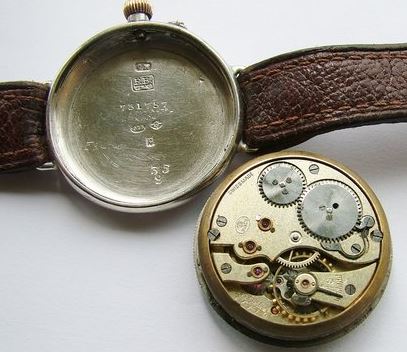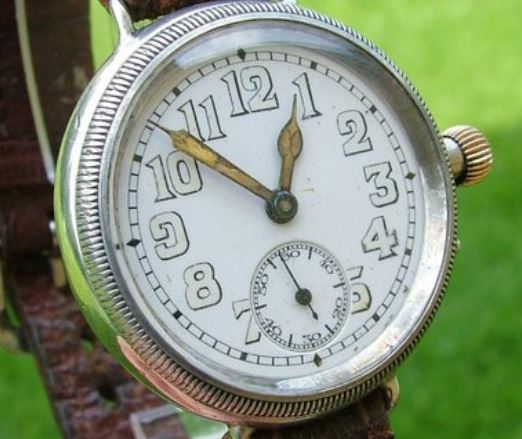Last updated on May 24, 2024
This trench watch has an IWC calibre 64 hand-winding movement which is working nicely. The movement is signed with the S&Co for Stauffer and also the Peerless name. Stauffer & Co. bought in movements from various companies including IWC. S&Co were a London-based subsidiary of Stauffer, Son & Co.
Stauffer
In 1830, Charles Philip Stauffer and his son Julius founded Stauffer, Son & Co., a watchmaking company based in Switzerland with a factory located in La Chaux-de-Fonds and an office in Geneva. Julius subsequently opened a London office to oversee the importation of watches from the Swiss factory and their sale in the British market, as well as the British Empire. Charles Nicolet (1853 – 1940) was a Swiss citizen who settled in London during the 1870s after studying watchmaking in La Chaux-de-Fonds, Switzerland. In London, Charles Nicolet worked for Stauffer, Son & Co., becoming a partner in the business in 1879. By the 1890s the London branch was selling so many watches that the Swiss factory couldn’t keep up with the demand, so Stauffer & Co. started to buy watches from other Swiss manufacturers, including IWC. The watches were, of course, marked with the S&C brand.
IWC
IWC (International Watch Company) was established in Schaffhausen, Switzerland in 1868 by American watchmaker Florentine Ariosto Jones. Jones’ goal was to merge Swiss watchmaking expertise with modern manufacturing techniques from the United States. His target market was intended to be America. The factory utilized hydroelectric power from the nearby river Rhine to power its machinery. Today, IWC is renowned as a luxury watchmaker, with its Pilot and Portugieser collections being particularly noteworthy.
All early IWC wristwatches either had the calibre 63 Lépine or calibre 64 Savonnette movement. They first appeared in the IWC movement and parts catalogue in around 1891-92. This particular movement is the calibre 64 and it has the Stauffer mark and also the Peerless name, together with the serial number 677769 which dates it back to 1916.
Calibre 64
The IWC calibre 64 was introduced in approximately 1892. These were used in small pocket watches at the time, but later appeared in IWC’s first wristwatches from 1906 until 1915. The calibre 64 has a straight line Swiss made lever escapement with a cut bimetallic temperature compensating balance, a Breguet overcoil balance spring and 15 jewels, with some jewels set in screwed chatons. It works at 18,000 vibrations per hour. The mainspring barrels have the patented IWC version of “Maltese cross” or Geneva stop work.

Geneva stopwork
The force that the mainspring delivers as it unwinds is not uniform in nature. If you wind a watch up all the way, the force delivered will be slightly higher than at the end of its wind. When a mainspring is wound all the way, the extension of its outer coils is large in comparison to its inner coils. Because of this, the delivered force is larger at the beginning of its unwinding than it is close to the end.
Therefore, a watch does not run at the same rate throughout its duration of run time, unless it has a constant force mechanism. A “stopwork,” mechanism is one such device. It limits the amount of winding and unwinding that the mainspring can go through, effectively evening the torque curve by cutting out the two extremes. The most famous stopwork style is the Geneva stopwork, also known as the Maltese cross mechanism.
Case
The watch itself measures 32mm in diameter excluding the fixed wire lugs and the winding crown. The case is silver and there are British hallmarks inside the case back for London (import mark), 1918 with a sponsor’s mark for Charles Nicolet of Stauffer & Co. The case has the odd mark but overall is very acceptable for such an early piece.
Borgel
The inside of the case back also has the mark for François Borgel. He was a very successful inventor and businessman. His company became one of the most influential watchcase manufacturers of its time. In 1891 Borgel patented the screw watch case design that most often bears his name today, the Borgel Case. He advertised his screw watch case, such as this example, as “imperméable”, which means that he considered it to be waterproof. It might have been considered waterproof at the time, but it certainly wouldn’t be comparable to modern dive watches. It is more likely that it was water resistant during normal day-to-day activities, which wouldn’t have included swimming or bathing. As with any antique watch, it would not be wise to consider it still being waterproof or even water resistant.
Screw case
The Borgel screw case was an innovative watch case that offered protection against dust and moisture. The case back and middle part were integrated, creating a sealed back. The front opening of the case was reinforced and internally threaded with a fine thread. The movement, dial, and hands were mounted on a carrier ring. The bezel, crystal, and carrier ring assembly were screwed into the case from the front. Since the movement screws in from the front, there must be a way to remove the stem. Borgel accomplished this by dividing the stem into two parts, with one attached to the movement and the other to the case. Consequently, most Borgel screw cases are outfitted with pin-set movements.
Early adopters of the Borgel screw case included Longines and IWC. François Borgel’s died in 1912 and the business was taken over by his daughter Louisa. The business was sold in 1924 to Taubert & Fils who carried it on until the 1970s. They supplied many watch manufacturers including Patek Philippe and Vacheron Constantin.
Dial
The white enamel dial is in lovely condition. The numbers would originally have had painted infill but this has been removed over the years. The glass crystal lens is in good condition. The cathedral-style hands still contain remnants of the luminous paint that would have allowed the time to be read in the dark. This paint contains radium and was commonly removed once its radioactive nature was fully understood. Originally, the paint would have also been applied to the hour markers.
Summary
This IWC trench watch is a good example of what the typical officer might have worn in the trenches in 1916. It has a good quality IWC movement, which by all accounts is still keeping good time to within a minute or two per day. The Borgel case provided the ultimate in water resistance at the time. It is a classic and innovative design and the Borgel case is much sought after by trench watch collectors.

